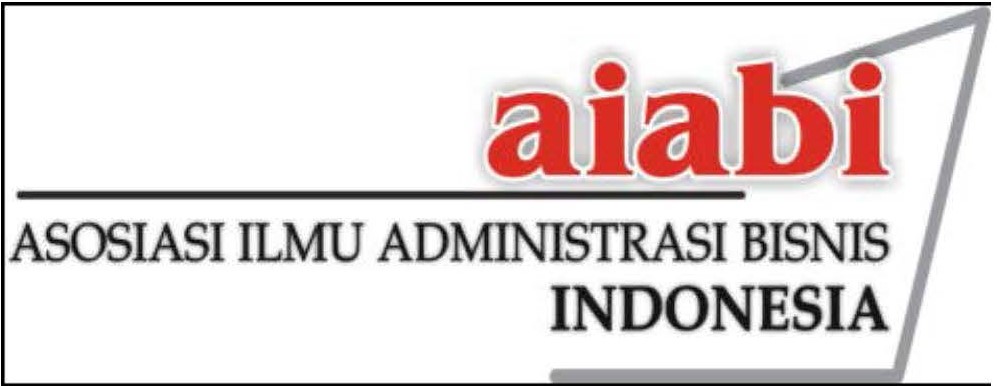PENGARUH STRATEGIC ORIENTATION, GOVERNMENT REGULATION TERHADAP GREEN SUPPLY CHAIN MANAGEMENT DAN ENVIRONMENTAL PERFORMANCE
Abstrak
This study examines and explains the relationship of income factor variables from the application of the green supply chain management concept, namely the strategic orientation and government regulation, and further effect on. The object of this research is small and medium enterprises which are associated with the traditional semi-modern greengrocery market in Malang Regency. This study uses census sample method by involving all the owners of traditional semi-modern greengrocery market. The results of this study indicate that, firstly, strategic orientation and government regulation have a significant positive impact on green supply chain management, secondly, green supply chain management has a significant positive effect on environmental performance, thirdly, strategic orientations and government regulation have a significant positive impact on environmental performance through green supply chain management.
Penelitian ini menguji dan menjelaskan hubungan variabel yang menjadi faktor income dari penerapan konsep green supply chain management , yaitu strategic orientation dan government regulation, yang kemudian membentuk environmental performance. Objek penelitian ini adalah usaha kecil menengah yang terasosiasi pada pasar sayur tradisional-semi modern Kabupaten Malang. penelitian ini menggunakan metode sampel jenuh dengan melibatkan seluruh pemilik UKM pasar sayur tradisional- semi modern. Hasil penelitian ini menunjukkan bahwa; pertama strategic orientation berpengaruh positif signifikan terhadap green supply chain management, kedua goverment regulation berpengaruh positif signifikan terhadap green supply chain management, ketiga green supply chain management berpengaruh positif signifikan terhadap environmental performance, keempat strategic orientation berpengaruh positif signifikan terhadap environmental performance melalui green supply chain management, dan yang kelima government regulation berpengaruh positif signifikan terhadap environmental performance melalui green supply chain management.
Kata Kunci
Teks Lengkap:
PDFReferensi
Al Zaabi, S., Al Dhaheri, N., & Diabat, A. (2013). Analysis of interaction between the barriers for the implementation of sustainable supply chain management. International Journal of Advanced Manufacturing Technology, 68(1–4), 895–905. https://doi.org/10.1007/s00170-013-4951-8
Banerjee, S. B. (2002). Corporate environmentalism: The construct and its measurement. Journal of Business Research, 55(3), 177–191. https://doi.org/10.1016/S0148-2963(00)00135-1
Chan, R. Y. K., He, H., Chan, H. K., & Wang, W. Y. C. (2012). Environmental orientation and corporate performance: The mediation mechanism of green supply chain management and moderating effect of competitive intensity. Industrial Marketing Management, 41(4), 621–630. https://doi.org/10.1016/j.indmarman.2012.04.009
Choi, D., & Hwang, T. (2015). The impact of green supply chain management practices on firm performance: the role of collaborative capability. Operations Management Research, 8(3–4), 69–83. https://doi.org/10.1007/s12063-015-0100-x
Chu, K. M. (2017). The Role of a Strategic and Sustainable Orientation in Green Supply Chain Management. International Journal of Sustainable Entrepreneurship and Corporate Social Responsibility, 1(2), 40–61. https://doi.org/10.4018/ijsecsr.2016070103
Chu, S. H., Yang, H., Lee, M., & Park, S. (2017). The impact of institutional pressures on green supply chain management and firm performance: Top management roles and social capital. Sustainability (Switzerland), 9(5). https://doi.org/10.3390/su9050764
Chun, S.-H., Hwang, H. J., & Byun, Y.-H. (2015). Green Supply Chain Management in the Construction Industry: Case of Korean Construction Companies. Procedia - Social and Behavioral Sciences, 186, 507–512. https://doi.org/10.1016/j.sbspro.2015.04.192
Clemens, B., & Douglas, T. J. (2006). Does coercion drive firms to adopt “voluntary” green initiatives? Relationships among coercion, superior firm resources, and voluntary green initiatives. Journal of Business Research, 59(4), 483–491. https://doi.org/10.1016/j.jbusres.2005.09.016
Desarbo, W. S., Benedetto, C. A., & Song, M. (2007). A heterogeneous resource based view for exploring relationships between firm performance and capabilities. Journal of Modelling in Management, 2(2), 103–130. https://doi.org/10.1108/17465660710763407
Graafland, J., & Smid, H. (2017). Reconsidering the relevance of social license pressure and government regulation for environmental performance of European SMEs. Journal of Cleaner Production, 141, 967–977. https://doi.org/10.1016/j.jclepro.2016.09.171
Ghozali, Imam. 2014. Structural Equation Modeling, Metode Alternatif dengan Partial Least Square (PLS). Edisi 4. Semarang : Badan Penerbit Universitas
Diponegoro
Hunt, C. B., & Auster, E. R. (1990). Proactive Environmental Management: Avoiding the Toxic Trap. Sloan Management Review, 31(2), 7.
https://id.wikipedia.org/wiki/Kabupaten_Malang, diakses Januari1st, 2019
https://dlh.jatimprov.go.id/kategori-51-elaporan.html, diakses Januari15st, 2019
http://www.malangkab.go.id/site/read/detail/79/selayang-pandang.html, diakses Februari1st, 2019
Jeswani, & Azopagic. (2011). Water footprint: Case study for Assessing the Impacts of water use. Journal of Cleaner Production, 19(12), 1288–1299.
KHAKSAR, E., ABBASNEJAD, T., ESMAEILI, A., & TAMOŠAITIENĖ, J. (2015). THE EFFECT OF GREEN SUPPLY CHAIN MANAGEMENT PRACTICES ON ENVIRONMENTAL PERFORMANCE AND COMPETITIVE ADVANTAGE: A CASE STUDY OF THE CEMENT INDUSTRY. Technological and Economic Development of Economy, 22(2), 293–308. https://doi.org/10.3846/20294913.2015.1065521
Kirchoff, J. F., Tate, W. L., & Mollenkopf, D. A. (2016). The impact of strategic organizational orientations on green supply chain management and firm performance. International Journal of Physical Distribution and Logistics Management, 46(3), 269–292. https://doi.org/10.1108/IJPDLM-03-2015-0055
Kohli, A. S., & Hawkins, E. (2015). Motivators to Adopt Green Supply Chain Initiatives. International Journal of Information Systems and Supply Chain Management, 8(4), 1–13. https://doi.org/10.4018/ijisscm.2015100101
Laari, S., Töyli, J., Solakivi, T., & Ojala, L. (2016). Firm performance and customer-driven green supply chain management. Journal of Cleaner Production, 112, 1960–1970. https://doi.org/10.1016/j.jclepro.2015.06.150
Lin, R. J., Tan, K. H., & Geng, Y. (2013). Market demand, green product innovation, and firm performance: Evidence from Vietnam motorcycle industry. Journal of Cleaner Production, 40, 101–107. https://doi.org/10.1016/j.jclepro.2012.01.001
Mensah, I., & Blankson, E. J. (2013). Determinants of hotels’ environmental performance: Evidence from the hotel industry in Accra, Ghana. Journal of Sustainable Tourism, 21(8), 1212–1231. https://doi.org/10.1080/09669582.2013.776058
Min, S., & Mentzer, J. T. (2011). DEVELOPING AND MEASURING SUPPLY CHAIN MANAGEMENT CONCEPTS. Journal of Business Logistics, 25(1), 63–99. https://doi.org/10.1002/j.2158-1592.2004.tb00170.x
Moorman, C., Deshpande, R., & Zaltman, G. (1993). Factors Affecting Trust in Market Research. Journal of Marketing, 57(1), 81–101.
Nadeem, K., & Siddiqui, D. A. (2018). The Effect of Strategic Orientation on Green Supply Chain Practices and Performance: A Case of Manufacturing Companies in Pakistan. Asian Business Review, 7(2), 59–70. https://doi.org/10.18034/abr.v7i2.12
Nezakati, H., Fereidouni, M. A., & Rahman, A. A. (2016). An Evaluation of Government Role in Green Supply Chain Management through Theories. International Journal of Economics and Financial Issues, 6(S5), 76–79.
Ninlawan, C., Seksan, P., Tossapol, K., Pilada, W., C, N., P, S., … W, P. (2010). The Implementation of Green Supply Chain Management Practices in Electronics Industry. In Proceedings of the International Multiconference of Engineers and Computer Scientists, 3(1), 17–19.
Rakhmawati, A., Rahardjo, K., & K. (2019). Faktor Anteseden dan Konsekuensi Green Supply Chain Management. JSINBIS (Jurnal Sistem Informasi Bisnis), 9(1), 1–8. Retrieved from https://ejournal.undip.ac.id/index.php/jsinbis/article/view/21102
Russo, M. V., & Fouts, P. A. (1997). A resource-based perspective on corporate environmental performance and profitability. Academy of Management Journal, 40(3), 534–559. https://doi.org/10.2307/257052
Savita, K. S., Dominic, P. D. D., & Ramayah, T. (2016). The Drivers, Practices and Outcomes of Green Supply Chain Management: Insights from ISO14001 Manufacturing Firms in Malaysia. INTERNATIONAL JOURNAL OF INFORMATION SYSTEMS AND SUPPLY CHAIN MANAGEMENT, 9(2), 35–60. https://doi.org/10.4018/IJISSCM.2016040103
Siguaw, J. A., Simpson, P. M., & Baker, T. L. (1998). Effects of Supplier Market Orientation on Distributor Market Orientation and the Channel Relationship: The Distributor Perspective Background and Definition of Market Orientation. Journal of Marketing Jul Journal of Marketing, 62(62), 99–111.
Sirmon, D. G., Hitt, M. A., & Ireland, R. D. (2007). Managing firm resources in dynamic environments to create value: Looking inside the black box. Academy of Management Review, Vol. 32, pp. 273–292. https://doi.org/10.5465/AMR.2007.23466005
Stefanelli, N. O., Jabbour, C. J. C., & Jabbour, A. B. L. de S. (2014). Green supply chain management and environmental performance of firms in the bioenergy sector in Brazil: An exploratory survey. Energy Policy, 75, 312–315. https://doi.org/10.1016/j.enpol.2014.06.019
Sugathan, S. K., Dominic, D. D., Ramayah, T., & Ratnam, K. A. (2015). The associating factors and outcomes of green supply chain management implementation – from the technological and non-technological perspectives. Advances in Intelligent Systems and Computing, 353, 491–501. https://doi.org/10.1007/978-3-319-16486-1_48
Tajuddin, Muhammad., Umar Nimran, Endang siti astuti, Kertahadi. (2015). Kesuksesan Sistem informasi Perguruan tinggi dan good university governance, Sebuah kajian empiris di perguruan tinggi swasta, Malang: UBPress
Umar, Husein. (2003). Metodologi Penelitian: Aplikasi dalam Pemasaran. Jakarta: Gramedia Pustaka Utama
Younis, H., Sundarakani, B., & Vel, P. (2016). The impact of implementing green supply chain management practices on corporate performance. Competitiveness Review, 26(3), 216–245. https://doi.org/10.1108/CR-04-2015-0024
Zhu, Q., Feng, Y., & Choi, S. B. (2017). The role of customer relational governance in environmental and economic performance improvement through green supply chain management. Journal of Cleaner Production, 155, 46–53. https://doi.org/10.1016/j.jclepro.2016.02.124
Zhu, Q., Sarkis, J., & Lai, K. hung. (2007). Green supply chain management: pressures, practices and performance within the Chinese automobile industry. Journal of Cleaner Production, 15(11–12), 1041–1052. https://doi.org/10.1016/j.jclepro.2006.05.021
Zhu, Q., Sarkis, J., & Lai, K. hung. (2007). Initiatives and outcomes of green supply chain management implementation by Chinese manufacturers. Journal of Environmental Management, 85(1), 179–189. https://doi.org/10.1016/j.jenvman.2006.09.003
DOI: https://doi.org/10.24198/adbispreneur.v4i3.19175
Refbacks
- Saat ini tidak ada refbacks.









